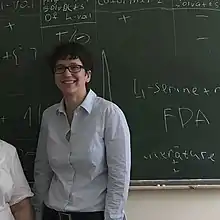Franziska L. Emmerling | |
|---|---|
 | |
| Alma mater | Albert-Ludwig University of Freiburg |
| Scientific career | |
| Institutions | Bundesanstalt fuer Materialforschung und -pruefung |
Franziska L. Emmerling (born 1975) is a German chemist. Emmerling is Head of Materials Cheimstry Department and Head of the Structure Analysis Division at the German Federal Institute for Materials Research and Testing (BAM).[1][2] She is a privatdozent at Humboldt University.
Early life and education
Emmerling was born in Bad Dürkheim.[3] She studied chemistry at Albert-Ludwig University, and completed her PhD at the same institution in 2003. Her doctoral work focused on the synthesis and structural investigation of intermetallic phases and ternary oxides of the elements arsenic, antimony and bismuth in unusual valence states.
Research and career
Emmerling conducted post-doctoral research in the group of Prof. Claudia Felser at Johannes Gutenberg University in Mainz. In 2005, Emmerling moved to the Federal Institute for Materials Research and Testing (BAM) in Berlin as head of the working group on X-ray structure analysis. From 2010 until 2013 she held a guest professorship in inorganic chemistry at Humboldt University in Berlin. In 2012 Emmerling became Head of the Division ‘Structure Analysis’ at BAM, before becoming Head of Department Analytical Sciences and Reference Materials in 2017.[4] Emmerling achieved her habilitation in chemistry in 2018 focusing on in situ analysis of mechanochemical reaction.
The current work of Emmerling focuses on the investigation of crystallization and aggregation phenomena by means of synchrotron radiation. She is also well known for her advances in mechanochemistry[5][6][7] and for developing new methods to monitor mechanochemical reactions in situ.[8][9] Emmerling develops and uses time-resolved experiments applying synchrotron X-rays, supplemented with additional analytic methods including Raman spectroscopy and XANES.
In 2019, Emmerling was elected as a member of the Analytical Chemistry Division of the International Union of Pure and Applied Chemistry (IUPAC) [10] Currently, she is Head of Materials Cheimstry Department and Head of the Structure Analysis Division at the German Federal Institute for Materials Research and Testing (BAM).[1][2]
References
- 1 2 "Department 6 - Materials Chemistry". www.bam.de. Retrieved 2023-10-12.
- 1 2 "Division 6.3 - Structure Analysis". www.bam.de. Retrieved 2023-10-12.
- ↑ GMBH, WISTA-MANAGEMENT. "Dr. rer. nat. Franziska Emmerling: The chemist at the Federal Institute for Materials Research and Testing (BAM) works on crystallization and aggregation phenomena by means of synchrotron radiation". www.adlershof.de.
- ↑ "Speakers". May 19, 2018.
- ↑ Kulla, Hannes; Michalchuk, Adam; Emmerling, Franziska (2019). "Manipulating the dynamics of mechanochemical ternary cocrystal formation". Chem. Commun. 55 (66): 9793–9796. doi:10.1039/C9CC03034D. PMID 31360937. S2CID 198982457.
- ↑ Stroh, Julia; Ali, Naveed; Maierhofer, Christiane; Emmerling, Franziska (2019). "Ettringite via Mechanochemistry: A Green and Rapid Approach for Industrial Application". ACS Omega. 4 (4): 7734–7737. doi:10.1021/acsomega.9b00560. PMC 6649167. PMID 31459862.
- ↑ Kulla, Hannes; Becker, Christian; Michalchuk, Adam; Linberg, Kevin; Paulus, Beate; Emmerling, Franziska (2019). "Tuning the apparent stability of polymorphic cocrystals through mechanochemistry". Cryst. Growth Des. 19 (12): 7271–7279. doi:10.1021/acs.cgd.9b01158. S2CID 208752733.
- ↑ Batzdorf, L; Fischer, F.; Wilke, M.; Wenzel, K.; Emmerling, F. (2015). "Direct In Situ Investigation of Milling Reactions Using Combined X‐ray Diffraction and Raman Spectroscopy". Angew. Chem. Int. Ed. 54 (6): 1799–802. doi:10.1002/anie.201409834. PMID 25529541.
- ↑ Kulla, H.; Haferkamp, S.; Akhmetova, I.; Rollig, M.; Maierhofer, C.; Rademann, K.; Emmerling, F. (2018). "In Situ Investigations of Mechanochemical One-Pot Syntheses". Angew. Chem. Int. Ed. 57 (20): 5930–5933. doi:10.1002/anie.201800147. PMID 29605971.
- ↑ "IUPAC Latest News".